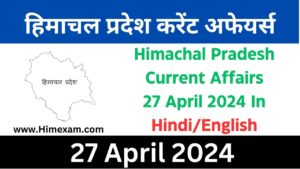Kinnaur District GK In English
Kinnaur District GK In English :-This post contains important information about Kinnaur district. Which is often asked in the paper of Himachal Pradesh. If you like this post then please share it further.
Read More:- Kinnaur District GK Notes In Hindi
Kinnaur Distt GK In English
| ❂ Formed as District | 1st May 1960 |
| ❂ District HeadQuarters | Reckong Peo |
| ❂ Population Density | 13(in 2011) |
| ❂ Literacy | 80.0 %(in 2011) |
| ❂ Total Area | 6401 Square Kilometers(of the area of 11.50 % Sq. Km) |
| ❂ Population | 84,121(in 2011) (of the Population of 1.23 %) |
| ❂ Sex Ratio | 819(in 2011) |
| ❂ Decadal Population Growth Rate | 7.39%(2001-2011) |
| ❂ Total Villages | 660(Populated Village-234) |
| ❂ Development Section | 03 |
| ❂ Gram Panchayats | 65 |
Kinnaur District GK In English
❂Geography
- Geographical location – Kinnour is a district in the east of Himachal Pradesh. It is situated between 31° 55″ 50 to 32° 05″ 15 North Latitude and 77° 45′ to 79° 04 35″ Eastern Longitude. Kinnaur is situated on the east by Tibet, on the south by Uttarakhand, on the west by Kullu, on the south and southwest by Shimla, and on the northwest by Lahaul Spiti district. Zaskar demarcates between Kinnaur and Tibet. The border of Kinnaur and Tibet starts from Parachhu and passes through Shipkila, Ranso, Shimdong and Gumrang passes.
- Valleys- Sutlej Valley is the largest valley of Kinnaur. The Hangrang Valley is situated along the Spiti River which joins the Sutlej near Khab village. Sunam or Ropaghati is formed by the Ropa River. Baspa Valley is also known as Sangla Valley. This valley is formed by the Baspa River. It is the most beautiful valley of Kinnaur. Kamru village is located in the Sangla Valley. The Tidong Valley is formed by the Tidong River. Bhabha is the largest village in Kinnaur located in the Bhabha Valley.
- Rivers- The Sutlej river divides Kinnaur into two equal parts. The Sutlej i is known as Juganti and Mukasung in Tibet. The Ropa River joins the Sutlej River near Shiyashu. Kasang, Taiti, Yula, Mulgun, Spiti and Baspa are the major tributaries of the Sutlej in Kinnaur.
- Lakes (Nako) : Lakes (located in Hongrang Tehsil) and Sorang (located in n I Nichar Tehsil) are the major lakes of Kinnaur.
- Forest : Niyoja tree is found only in Kinnaur throughout the country.
❂History
- Ancient History- The present Kinnaur was part of the ancient princely state of Bushahr. The nrimiiua easte of Kinnaur is believed to have originated from the divine leela. A description of the Kinnar caste is found in the Amarkosh text. In Hinduism, the Kinnar people are called Ashwamukhi and Kim + narah (what type of male). Tibetan people call Kinnaur as Khunu. Kinnaur, Bushahr and Kamru in Ladakh are called mone. The inhabitants of Kinnaur were khas in ancient times. Kinnaur Rajputs who were tribes of Khas were divided into Kanait and Jad. The Pandavas spent 12 years exile in Kinnaur. Kalidas has described kinners in his book Kumarasambhava. In the Vayu Purana, the kinners have been described as resident of the Mahananda Mountains. Establishment of Princely State – Chandravanshi King Pradyuman of Banaras established the capital at Kamru and laid the foundation of the Bushahr princely state. The advent of Buddhism – Between the seventh to the tenth century, Buddhism and Bhotia language came into effect in Kinnaur, coming under the influence of the Goge empire of Tibet.
- Medieval History – Busahar state was one of the three major powers of Shimla hill states along with Bilaspur and Sirmaur. Raja Chatar Singh was the 10th ruler of the princely state of Bushahr. Chatar Singh shifted his capital trom Kamru to Sarahan. The most effective ruler of the princely state, Kehri Singh, son of Raja Chatar Sing also known as Ajanbahu’, was given the title of ‘Chhatrapati’ by the Mughal emperor Aurangzeb. In u Tibet-Ladakhi Mughal War, King Kehri Singh sided with the Tibetans, due to which the Hangrang Valey was gifted to Bushahr by Tibet and free trade started between Tibet and Bushahr state. Kalyan Singh, e great-grandson of Chatar Singh, made the city of Kalyanpur its capital.
- Modern History
Gorkhas Invaded-After the death of Kehri Singh, his minor son Mahendra Singh ascended the throne. The Gorkhas invaded the princely state of Bushahr from 1803 to 1815 and captured Sarahan. King Mahendra Singh made his camp in Kamru. Wazir Tikka Ram and Badri Prasad led the war against the Gorkhas. The invasion of the Gorkhas was prevented by breaking the Wangtu bridge over the Sutlej River.
Rampur (Bushahar) – Raja Ram Singh (1767-99 AD) of the princely state of changed the capital Rampur from Sarahan and laid the foundation of the city of Rampur.”
Rebellion of 1857 AD – King Shamshar Singh of the princely state of Bushahr did not assist the British in the revolt of 1857 AD, which was complained by William Hay DC of Shimla.
Raja Shamsher Singh – Raja Shamsher Singh’s revolt in 1854 AD against the revenue tax of Wazir Munshi Lal in 1854 AD. Raja Shamsher Singh was forced to relinquish the throne in favor of his son Tikka Raghunath Singh in 1887 AD. Tikka Raghunath Singh laid the foundation of the Chinese Tehsil in 1895 AD.
Raja Padam Singh – Raja Padam Singh was considered as the King of Rampur Bushahr by the British in 1914 AD. Raja Padam Singh became the last king of Rampur Bushahr. He remained the king of Rampur Bushahr until independence. Raja Padam Singh accepted the merger of Rampur Bushahr in India with the efforts of agitators like Master Annulal, Satyadev Bushahri. In 1948, the Bushahr state was merged with Himachal Pradesh. Virbhadra Singh (6 times Chief Minister) is the son of Padam Singh who belongs to the 131st generation of the state of Bushahr. The present Kinnaur district was known as Chini Tehsil of Mahasu district before 1960. On 21 April 1960, Chini tehsil was separated from Mahasu district and became the sixth district of Himachal Pradesh by the name of Kinnaur.
❂ Culture, Festivals, Customs –
The practice of dubant, phukant and bhakant of dead bodies is prevalent in Kinnour after death. - Marriage is the arranged marriage in Kinnaur. Damchal Shish, Damtang Shish, Jujish is love marriage. Darosh, Dubdub, Hachish, Namesha Depang are the types of forced marriage. ‘Har’ is a marriage done to another’s wife.
- Festivals-
Chhatrail festival – This festival is celebrated in Chargaon in Chaitra month. This festival is famous for its vulgarity.
The Dakherni festival is celebrated in the month of Sawan. Ukhayang or Phulach festival – It is a festival of flowers which is most famous in Kinnaur. It is celebrated between August and October. Apart from this, Faguli, Losar, Jagro, Sajo, Khepa, Chhango Shesul and Eratang are the famous festivals of Kinnaur.
Toshim festival – This festival is celebrated by unmarried men. Local liquor ‘Ghanti’ is consumed in it. - Food – Wheat is known as Rejat, Zod, Tho and Oja. Barley is known as Tug, Chha, Chhak, Nun in Kinnaur. Makki is known as “Chhaha”. Sutarle is a festival dish. Sanpoole is a dish like Jalebi. Kaoni is salty barfi. In Kinnaur, it is said to eat breakfast, lunch for lunch and dinner for dinner. ‘Chhang’ in Kinnaur is a native liquor which is mainly drunk in the Hangrang Valley. ‘Ghanti’ is a local liquor made from barley. Ribba Valley is famous for its grapes, hence Ribba is also called ‘Valley of grapes’.
- Dress” Chhamu ‘is a shirt worn by men. ‘Chhamu Suthan’ is a woolen pajamas worn by men. Thepang is the name of the Himachali cap. Women wear dhori, choli and gachang. The ‘Chhanli’ is the name of the shawl.
- Lavi Fair – King Kehri Singh of Bushahr started Lavi Fair in Rampur in 1683 AD. It is a trade fair from where trade was done from Tibet. It is the oldest fair of the H.P.
❂ Economy and Education - Education:-There is a Navodaya School in Reckong Peo. The first primary school opened in Kinnaur in 1890 AD in Chinese. In 1899, a second primary school was opened in Pooh.
- Economy – Sheep breeding center in Kadcham of Kinnour.
- Minerals have been found in copper Rangavar of Kinnour, porcelain in Asranga, frospar in Wangtu and asbestos in Tangling. Pyrite and silver particles have been found at Chargaon in Kinnaur. Gypsum deposits have been unearthed in slate and moths in the Sangla Valley.
- Hydroelectric Projects – Sanjay Hydroelectric Project (Bhabha) 120 MW, Nathpa Jhakri Project (1500 MW). Vaspa Hydroelectric Project are the major hydroelectric projects of the district.
❂Important place
- This tehsil formed in Chinese 1895 AD has also been the headquarters of Kinnaur. It was the favorite residence of Lord Dalhousie. Dalhousie built the Hindustan Tibet Road while living in Chinese.
- Kalpa-kalpa was the headquarters of Kinnaur before Recang Peo.
- Chitkul – It is the last village of Baspa Valley.
- Kamru was located in Kamru, the ancient capital of the princely state of Bushahr. There is a Kamaksha Devi temple in the 5-storey royal fort here.
❂Demographic Statistics –
The population of Kinnaur increased from 27,232 in 1901 AD to 34,475 in 1951 AD. The population of Kinnaur increased from 49,835 in the year 1971 to 84,121 in 2011. The population of Kinnaur recorded a decline between 1911 and 1921 (0.98 %) while the highest increase was recorded between 1961 and 1971 (21.61%). The sex ratio of Kinnaur increased from 911 in 1901 to 1070 in 1951. It decreased to 887 in the year 1971. The sex ratio of Kinnaur in the year 2011 has been reduced to 819 (minimum). Kinnaur’s mass density has increased from 8 in 1971 to 13 in 2011. Kinnaur has a population of 9.73% and a population of 71.83%. Kinnaur district contributed 1.23% of the population of Himachal Pradesh in 2011. The decadal growth rate in 2001-2011 was 7.39%. Kinnaur had a literacy rate of 80% in 2011. There are a total of 660 villages in Kinnaur out of which 234 are inhabited villages. Kinnaur has 65 gram panchayats.❂ Location of Kinnaur – Kinnour Lahaul is the third largest district after Spiti and Chamba. The population of Kinnaur is the least (11th place) after Lahaul Spiti. The decadal population growth of Kinnaur between 2001- 2011 is the lowest (11th position) after Lahaul Spiti. Kinnaur also ranks 11th in population density. Kinnaur district had the lowest sex ratio (in 2011) at 819. Kinnaur was third in infant sex ratio (0-6 years) in 2011 with 952. Kinnaur was eighth in literacy (in 2011). 100% of the population of Kinnaur is rural. Only 9.4% area of Kinnaur is forested which is the lowest after Lahaul Spiti (1939). Kinnaur has the least number of small scale industries. Kinnaur came second in apple production in 2011-12, after Shimla. 53290 tonnes of apples were produced in Kinnaur. Kinnaur ranks first in grape production.
More Pages:-
हेलो दोस्तों ,आपका हमारी वेबसाइट Himexam.com पर स्वागत है। जैसा की आपको पता है हमारी वेबसाइट Himexam.com आपको समय-समय पर सभी HP Govt Jobs & All India Govt Jobs की Notifications प्रदान करवाती है। साथ ही साथ Himachal Pradesh Exam Previous Paper और Himachal Pradesh GK ,Himachal Pradesh & National +International Current Affairs के सभी नोट्स मुफ्त उपलब्ध करवाते है। हमारी वेबसाइट के अलग अलग प्लेटफार्म पर pages & Group बने है जैसे की facebook ,Telegram और Instagram .. अगर आप हिमाचल के किसी भी पेपर की तैयारी कर रहे हो तो जल्दी से इन groups के साथ जुड़ जाएं इनके लिंक नीचे table में दिए गए है।
Join Us:-
| Like Our Facebook Page | Click here |
| Join Us oN Telegram | Click here |
| Join Us On Instagram | Click Here |




